Hai mai trascorso ore su un progetto di ricamo solo per vedere punti irregolari, tessuto increspato, o disegni distorti?
La verità è, il problema di solito non è la tua macchina; è tuo servizio di digitalizzazione del ricamo a macchina. Una buona digitalizzazione trasforma la tua idea in un file di ricamo impeccabile; una cattiva digitalizzazione rovina anche i migliori progetti.
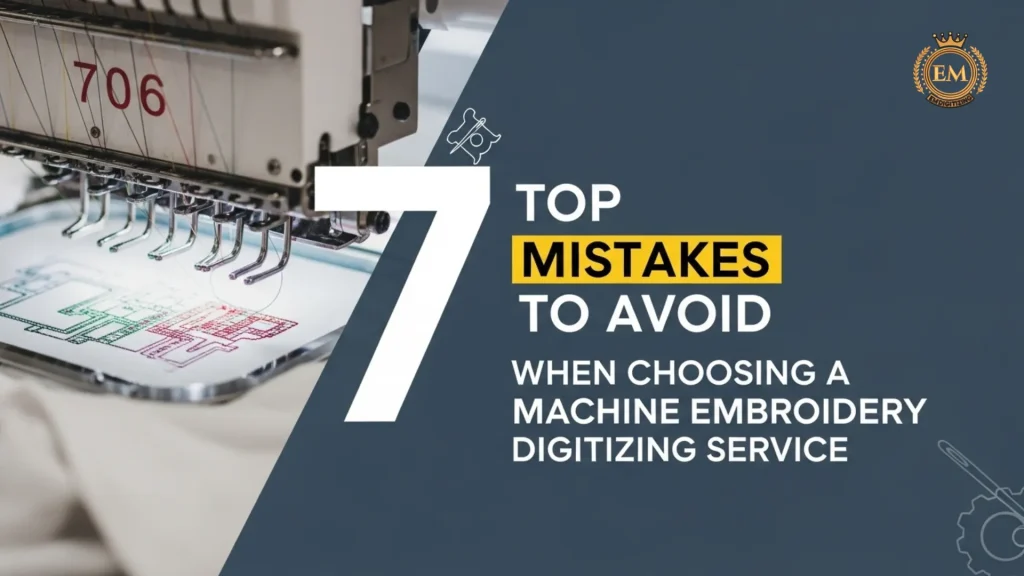
Scegliere il servizio giusto fa la differenza tra “wow” e “cosa è successo”.?"
Ecco alcuni degli errori più comuni che le persone commettono quando scelgono o utilizzano i servizi di digitalizzazione:
- Non controllare come gestiscono progetti complessi
- Ignorando come ottimizzano per diversi tessuti
- Dimenticarsi di controllare i tempi di consegna per gli ordini urgenti
- Trascurare la comunicazione e la reattività
- Non chiedere informazioni sulla politica di revisione prima di ordinare
- Supponendo che tutti i file digitalizzati automaticamente siano abbastanza buoni
- Dimenticare di controllare la qualità e la densità del punto
Evitare questi errori può aiutarti a ottenere punti più lisci, risultati più puliti, e una finitura professionale ogni volta.
Superiore 7 Errori da evitare quando si sceglie un servizio di digitalizzazione del ricamo a macchina
Errore #1: Non controllare come gestiscono progetti complessi
Questo è il primo e più comune errore che le persone commettono: non controllano come si comporta la squadra disegni complessi.
Tutti guardano semplici loghi o esempi di testo di base, pensa “sembra a posto," ed effettua un ordine. Ma una volta che il disegno ha lettere minuscole, linee sottili, o dettagli sfumati, è allora che le cose vanno male.
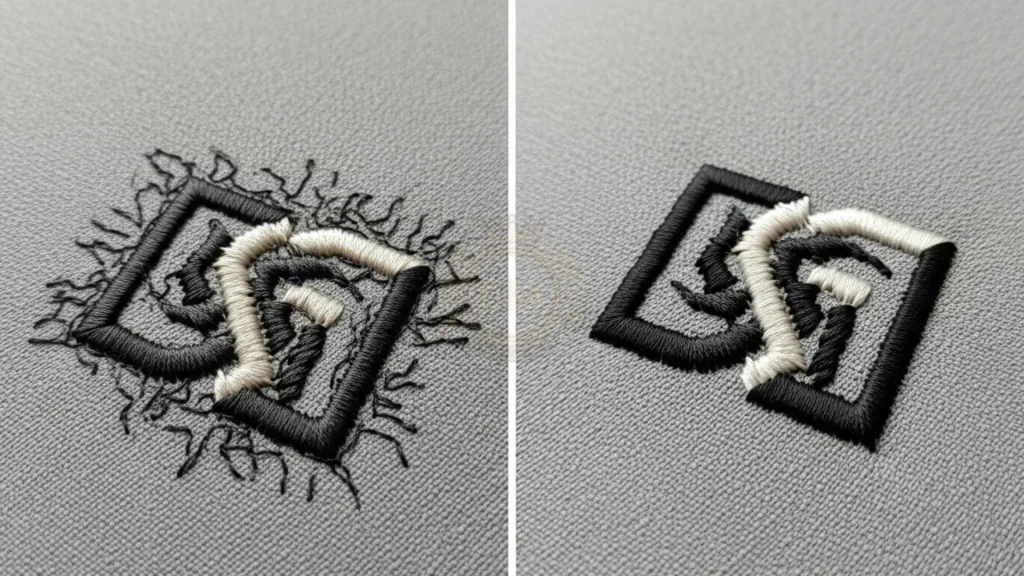
Un digitalizzatore professionista sa che i disegni complessi necessitano di una corretta direzione del punto, densità, sottosopra, e il percorso per mantenere il ricamo liscio e pulito.
Se il digitalizzatore non è abbastanza esperto, dovrai affrontare fili spezzati, riempimenti irregolari, o addirittura grinze del tessuto, e il risultato finale non assomiglierà per niente alla tua opera d'arte originale.
Prima di fidarsi di qualsiasi servizio, prenditi sempre qualche minuto per verificare come gestiscono il lavoro dettagliato:
- Richiedi campioni con dettagli fini o ombreggiature.
- Ingrandisci l'aspetto liscio dei punti.
- Assicurati che eseguano la digitalizzazione manuale, non solo una rapida conversione del software.
- E vedi se danno consigli onesti quando il tuo disegno è troppo dettagliato per essere cucito bene.
Ricorda, i progetti complessi mostrano la vera abilità di un digitalizzatore. Se riescono a gestirli con precisione, tutto il resto verrà perfetto, pure.
Errore #2: Ignorando come ottimizzano per diversi tessuti
Ecco qualcosa a cui molte persone non pensano mai quando ordinano da a servizio di digitalizzazione del ricamo a macchina: lo stesso design non funziona su ogni tessuto.
Ciò che sembra perfetto su a maglietta potrebbe apparire totalmente distorto su un berretto o una giacca. Eppure la maggior parte delle persone salta questa domanda quando assume un digitalizzatore, ed è qui che iniziano i problemi.
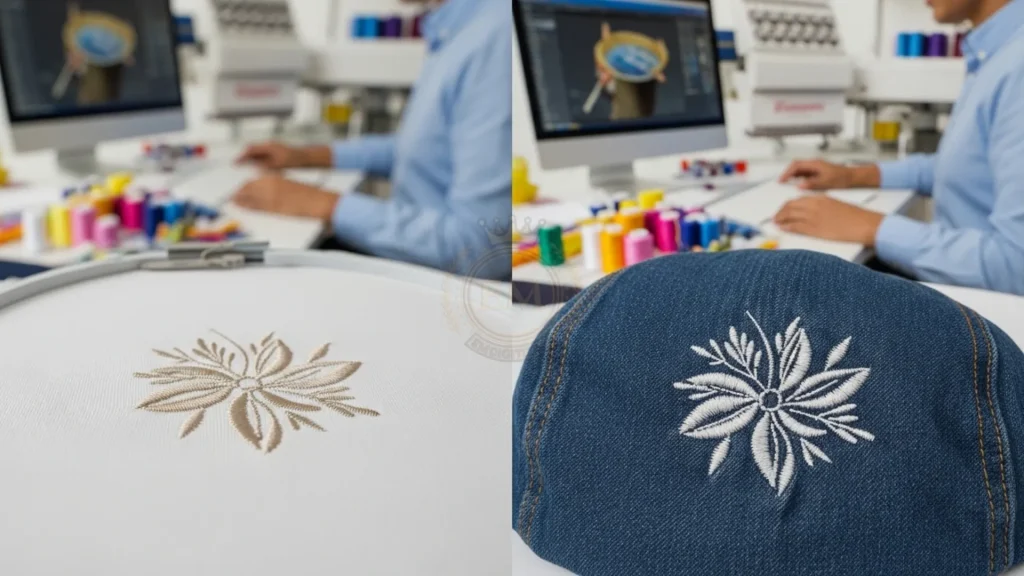
Ogni tessuto reagisce in modo diverso ai punti. Morbido, i materiali elastici come il jersey richiedono una densità leggera e un buon sottofondo, mentre i tessuti spessi come il denim o la tela richiedono una compensazione della trazione più forte. Se il digitalizzatore utilizza le stesse impostazioni per tutti, dovrai affrontare comuni mal di testa:
- Arricciature o deformazioni del tessuto
- Spazi o punti di riempimento irregolari
- Il filo si rompe durante la cucitura
- Disegni che perdono la loro forma originale
Un servizio professionale ti chiede sempre quale tessuto stai utilizzando prima di iniziare. Sanno come regolare il tipo di punto, direzione, e densità per adattarsi a quel materiale specifico.
Questo è ciò che fa la differenza tra una media file di ricamo e uno che cuce in modo pulito, senza intoppi, e meravigliosamente ogni volta.
Quindi la prossima volta che ordini, non inviare semplicemente l'opera d'arte, menziona anche il tuo tessuto. Un buon digitalizzatore saprà immediatamente quali modifiche apportare, e il tuo risultato finale sarà impeccabile su qualsiasi materiale.
Errore #3: Dimenticarsi di controllare i tempi di consegna per gli ordini urgenti
Questo è uno di quegli errori che all’inizio sembrano piccoli ma che in seguito possono causare enormi problemi. La maggior parte delle persone invia il proprio design, presumo che sarà pronto presto, e non chiedere mai per quanto tempo conversione del disegno di ricamo ci vorrà.
Poi le scadenze si avvicinano, i clienti iniziano ad aspettare, e il file non è ancora pronto, tutto perché non hai confermato i tempi di consegna.
Ogni disegno è diverso, alcuni richiedono minuti, altri necessitano di ore di attenta digitalizzazione manuale. Se non conosci i tempi di consegna, potresti finire per ritardare l'intera linea di produzione.
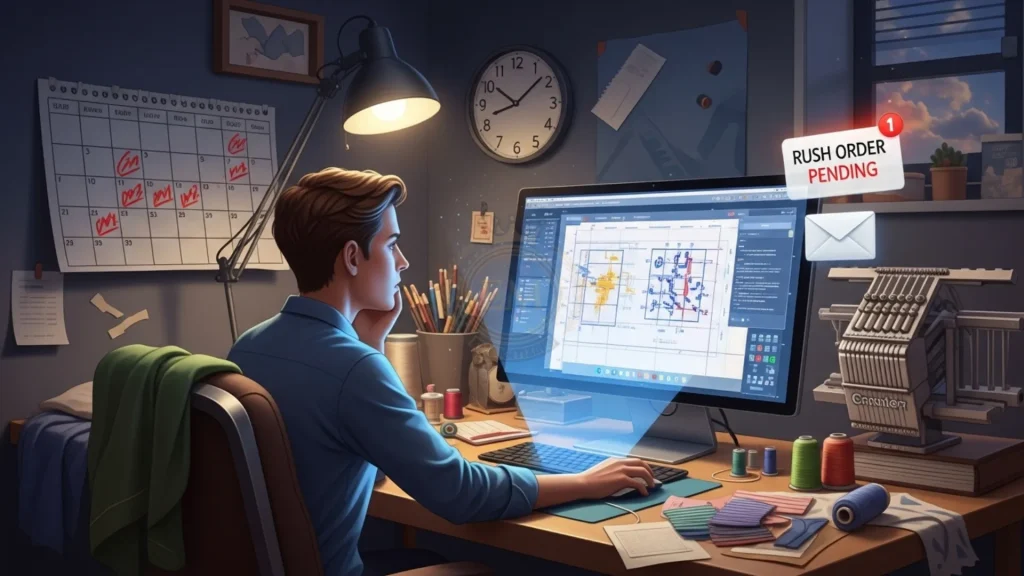
E se il tuo progetto riguarda un ordine cliente o un lavoro di ricamo in serie, questi ritardi possono costarti tempo e reputazione. Un professionista ti offre sempre una finestra di consegna chiara, se lo è 4 ore, 12 ore, o consegna il giorno successivo per progetti complessi.
Prima di effettuare qualsiasi ordine, fai sempre alcune domande chiare:
- Quanto tempo ci vorrà per convertire il mio progetto?
- Offrono opzioni di consegna urgente o espressa?
- I progetti complessi o dettagliati richiederanno più tempo?
- Possono aggiornarti se succede qualcosa di inaspettato?
Una comunicazione chiara sui tempi ti evita stress inutili. Così, non saltarlo mai, sapere esattamente quando il tuo disegno del ricamo la conversione sarà pronta ti aiuta a pianificare meglio e a consegnare i tuoi progetti nei tempi previsti.
Errore #4: Trascurare la comunicazione e la reattività
Questo potrebbe sorprenderti, ma scegliere una squadra che non comunica correttamente può rovinare la tua intera esperienza di ricamo. Anche se la qualità è buona, una comunicazione lenta o poco chiara può ritardare i tuoi progetti, causare confusione, e lasciarti frustrato.
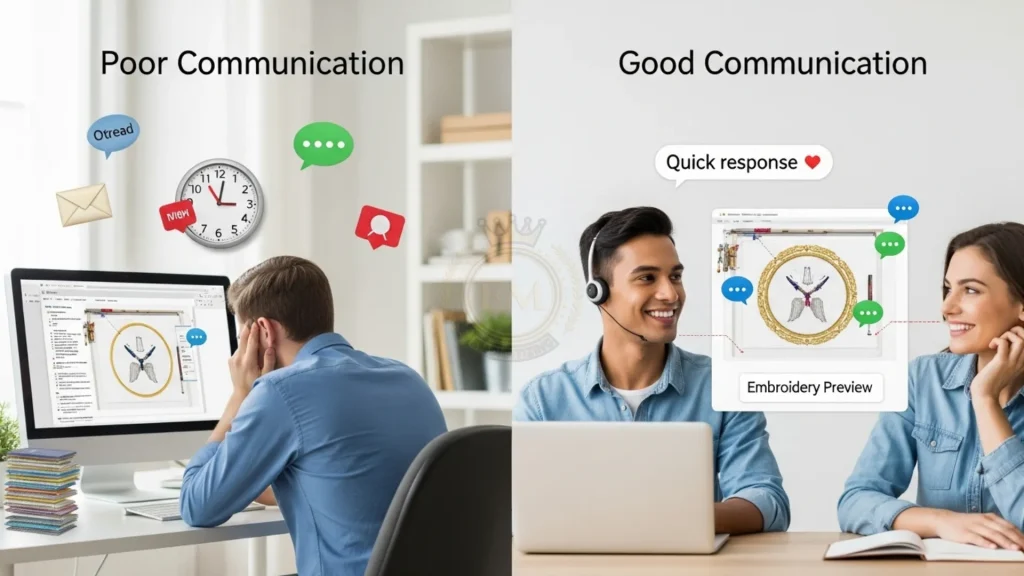
Quando lavori con a servizio di digitalizzazione del ricamo a macchina, non stai pagando solo per un file, stai pagando per a processi. Hai bisogno di aggiornamenti, revisioni, e talvolta soluzioni rapide. Se il team impiega giorni per rispondere o ignora le tue domande, diventa impossibile far funzionare le cose senza intoppi.
Pensaci, cosa succede se il tuo file necessita di una piccola correzione prima della scadenza del cliente, ma nessuno risponde 12 ore? Perdi tempo, soldi, e forse anche la fiducia del cliente.
Ecco come evitare questa situazione:
- Scegli un servizio che risponda velocemente e comunichi in modo chiaro.
- Metti alla prova il loro supporto una volta prima di effettuare un grosso ordine, inviare un messaggio e vedere quanto velocemente rispondono.
- Preferisci le squadre che offrono 24/7 supporto o revisioni rapide.
- Nota quanto è educato, professionale, e utili sono le loro risposte; la dice lunga su come tratteranno i tuoi progetti reali.
Un servizio reattivo non si limita a fornire file; crea fiducia. Una buona comunicazione significa modifiche più rapide, meno errori, e un rapporto di lavoro più fluido ogni volta.
Errore #5: Non chiedere informazioni sulla politica di revisione prima di ordinare
Ammettiamolo: anche i migliori progetti a volte necessitano di piccoli aggiustamenti. Forse le dimensioni sembrano un po' fuori luogo, un punto lettera è troppo spesso, oppure il tessuto si comporta diversamente dal previsto. Ma è qui che la maggior parte delle persone sbaglia: effettuano un ordine senza chiedere cosa succede se sono necessarie modifiche in seguito.
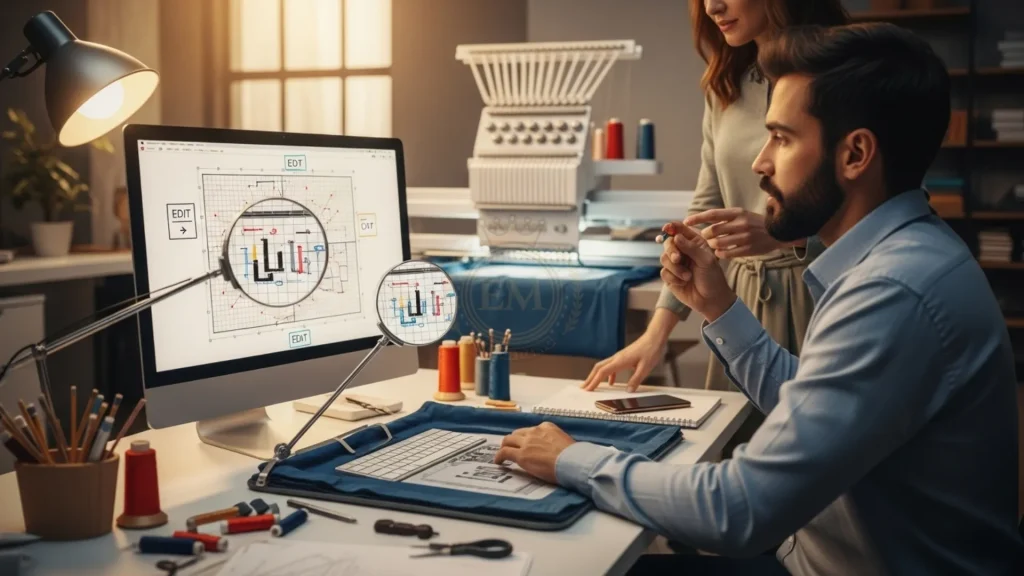
Un affidabile servizio di file di ricamo comprende che le revisioni fanno parte del processo. Di solito offrono una o due modifiche gratuite per correzioni di qualità o aggiustamenti del formato.
Ma molti servizi più economici richiedono un costo aggiuntivo anche per una piccola modifica, e ciò può trasformare una semplice correzione in stress e spese inutili.
Quindi, prima di premere il pulsante "ordina"., assicurati di chiedere:
- Quante revisioni gratuite sono incluse?
- Ciò che conta come “maggiore” vs. cambiamento “minore”.?
- Quanto velocemente gestiscono le richieste di revisione?
- Mantengono il tuo progetto in archivio per futuri aggiornamenti?
Una chiara politica di revisione dimostra professionalità e attenzione al cliente. Significa che il team non si limita a consegnare un file; sostengono il loro lavoro e vogliono che il tuo ricamo finale sia impeccabile, non importa quante piccole modifiche siano necessarie.
Errore #6: Supponendo che tutti i file digitalizzati automaticamente siano abbastanza buoni
Questo è uno dei malintesi più comuni, pensando che un software automatico possa sostituire le competenze di un vero digitalizzatore.
La digitalizzazione automatica potrebbe sembrare semplice e veloce, ma raramente produce la precisione necessaria per cuciture lisce, contorni puliti, o densità equilibrata. Semplicemente non è in grado di leggere l'opera d'arte come può fare un professionista qualificato.
Quando ti affidi solo agli strumenti automatici per digitalizzazione di loghi per macchine, i piccoli dettagli spesso vanno persi, il testo fine diventa voluminoso, i gradienti sembrano irregolari, e i percorsi dei punti diventano disordinati.
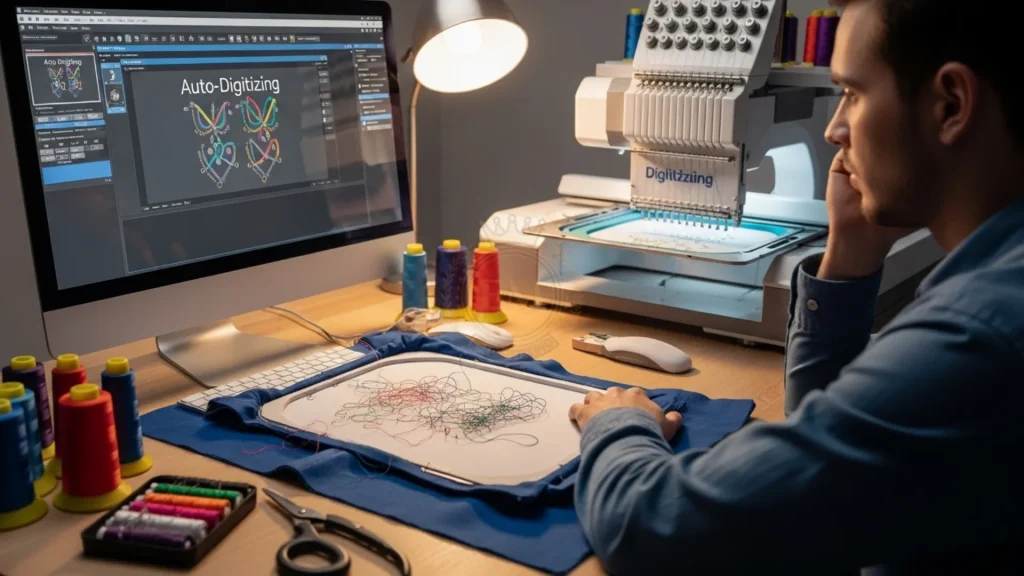
Il risultato? Il filo in eccesso si rompe, materiale sprecato, e disegni che sembrano poco professionali sul tessuto.
Un professionista servizio di digitalizzazione del ricamo a macchina non si limita a fare clic su un pulsante; regolano i tipi di punto, angoli, e sottofondi manualmente per assicurarti che ogni parte del tuo disegno venga cucita perfettamente. Capiscono come i punti interagiscono con il tessuto, tensione, e tipi di filo, qualcosa che il software non può veramente calcolare.
Così, se vuoi risultati che sembrino nitidi, durevole, e di alta qualità, non dipendono solo dalla digitalizzazione automatica. Affidati a veri esperti che trattano ogni progetto come un pezzo personalizzato, non solo un'altra conversione di file.
Errore #7: Dimenticare di controllare la qualità e la densità del punto
Ultimo, ma non per importanza: questo errore può creare o distruggere i risultati del ricamo. La maggior parte delle persone dà un'occhiata all'anteprima del progetto e presume che sia pronta, senza rendersi conto che la qualità e la densità del punto determinano quanto è bello (o male) cucirà.
Se i punti sono troppo fitti, il tessuto può diventare rigido, grinza, o addirittura lacrimare. Se sono troppo larghi, vedrai delle lacune, riempimenti irregolari, e scarsa copertura. Entrambe le situazioni possono trasformare un progetto straordinario in un disastro una volta che colpisce la macchina.
Ecco perché esperto digitalizzazione del ricamo a macchina i professionisti testano e regolano sempre la densità in base al tessuto, tipo di filo, e dimensione del disegno. Sanno che il flusso regolare del punto e la tensione equilibrata sono ciò che rende il ricamo pulito e professionale.
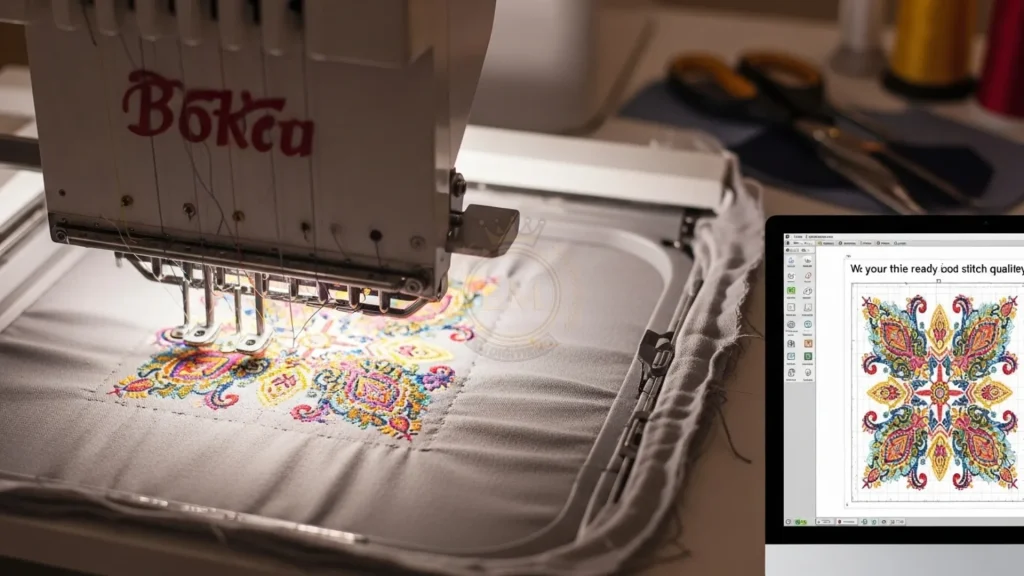
Prima di approvare qualsiasi progetto, prenditi un momento per:
- Osserva attentamente l'anteprima del punto o l'immagine campione.
- Assicurati che i riempimenti e i bordi appaiano bilanciati.
- Verifica che il tuo digitalizzatore personalizzi la densità per i diversi tessuti.
È un piccolo dettaglio, ma fa la differenza. La perfetta qualità dei punti significa che il tuo disegno non solo avrà un bell'aspetto, ma durerà anche più a lungo e cucirà senza intoppi ogni volta.
Conclusione | Evita questi errori e scegli il partner di digitalizzazione giusto
Ora hai visto quanto sono piccoli gli errori, come saltare i controlli dei punti, ignorando i tipi di tessuto, o scegliendo una scarsa comunicazione, può rovinare completamente un progetto di ricamo. La buona notizia è, puoi evitare tutto questo facilmente scegliendo professionisti che sanno esattamente cosa stanno facendo.
Se vuoi disegni che si cucino perfettamente fin dalla prima volta, sembrare pulito, e riflettono la vera qualità, EMDigitalizzazione è il nome di cui ti puoi fidare.
Nostro servizio di digitalizzazione del ricamo a macchina è gestito da esperti qualificati che creano manualmente ogni disegno con precisione, nessuna scorciatoia, nessuno strumento automatico, solo pura qualità. Garantiamo che i tuoi file di ricamo siano accurati, liscio, e pronto per qualsiasi tessuto o macchina.
Offriamo anche tempi di consegna super rapidi e 24/7 supporto, così i tuoi progetti non subiranno mai ritardi o confusione.
Quindi non aspettare, ordina ora E ottieni 50% dal tuo primo progetto con EM Digitalizing, e sperimenta la differenza che fa la digitalizzazione professionale.
Domande frequenti
Un servizio di digitalizzazione del ricamo a macchina converte il tuo disegno o logo in un file di punti digitale che le macchine da ricamo possono leggere. Questo processo garantisce che i punti del tuo disegno siano accurati, pulito, e con dettagli perfetti sul tessuto.
Il ricamo a macchina utilizza cuciture computerizzate per precisione e velocità, mentre il ricamo a mano viene eseguito manualmente con filo e ago. Il ricamo a macchina consente risultati costanti e produzione di massa, mentre il ricamo a mano offre un aspetto più personale, tocco artistico.
I formati di file di ricamo comuni includono DST, PES, JEF, SCAD, VP3, e HUS. Il formato dipende dal tipo di macchina da ricamo utilizzata, e digitalizzatori professionali possono consegnare il tuo file nel formato che ti serve.
Puoi semplicemente inviare il tuo logo o la tua grafica in formati come JPG, PNG, o PDF al servizio di digitalizzazione. Lo convertiranno in un file di ricamo pronto per il ricamo e condivideranno con te il file finale una volta testato e approvato.
L'utilizzo di un servizio di digitalizzazione professionale garantisce che il tuo ricamo abbia un aspetto pulito, durevole, e accurato. Digitalizzatori esperti regolano manualmente i punti, densità, e sottofondo per risultati perfetti facendoti risparmiare tempo, materiali, e frustrazione.
